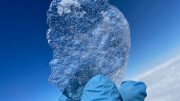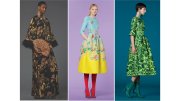Among natural objects, blue is perhaps the rarest color. Chlorophyll in plants creates their familiar green—giving way, in some species, to carotenoid and anthocyanin pigments that create the brilliant purples, reds, oranges, and yellows of fall. Cave paintings from prehistoric times show browns and reds—earth colors derived from minerals in soil—but no blue. Indigo and lapis lazuli later broadened the palette, but their color remains uncommon in living things.
When blue does appear—in a blue jay’s feathers, for instance, or a morpho butterfly’s wing—it is often created through unusual means. Most colors in nature are chemical in origin. Pigment molecules absorb certain wavelengths of light, corresponding to particular colors, while reflecting others; chlorophyll, for instance, reflects green. By contrast, some colors—and frequently blue—are structural: when light reaches the narrow grooves of a compact disc or the microscopic ridges of a peacock’s tail feather, it bounces and scatters. Wavelengths of light that match the nanoscale distance between ridges are amplified, while other wavelengths cancel out. The materials lack hue of their own without their particular structure. Grind them up, and their color disappears.
A team of researchers led by Vinothan N. Manoharan, McKay professor of chemical engineering and professor of physics, is working to create structural colors in the lab. Their inspiration comes in part from research on the cotinga, a tropical bird whose bright blue color comes from sponge-like pockets of air in its feathers’ coating of keratin, the protein that makes up hair and fingernails. As light travels through this maze of keratin and encapsulated air, some wavelengths of light cancel each other out, while others reinforce one another to create the color blue.
In the engineers’ formulation, microscopic flecks of color function like feathers in miniature. Each is a tiny, water-filled microcapsule containing a suspension of even tinier particles of plastic, which bounce light like the cotinga feathers’ air-filled pores. What’s more, the capsules shrink as they dry, packing the plastic particles inside more densely, thus changing the color produced—until a dose of ultraviolet light cures the capsules, freezing their hue. In this way, chemically identical materials can yield a spectrum of color, from red to green to blue.
Manoharan and his colleagues are now working to intensify the colors produced; red, in particular, needs work. They hope their structurally colored materials may one day function in screens and displays, as well as in nontoxic paints and cosmetics. For paints especially, structural color has another advantage: light absorbed by traditional pigments triggers chemical reactions that cause them to fade over time. For structural colors, which could potentially endure, the future is bright.











